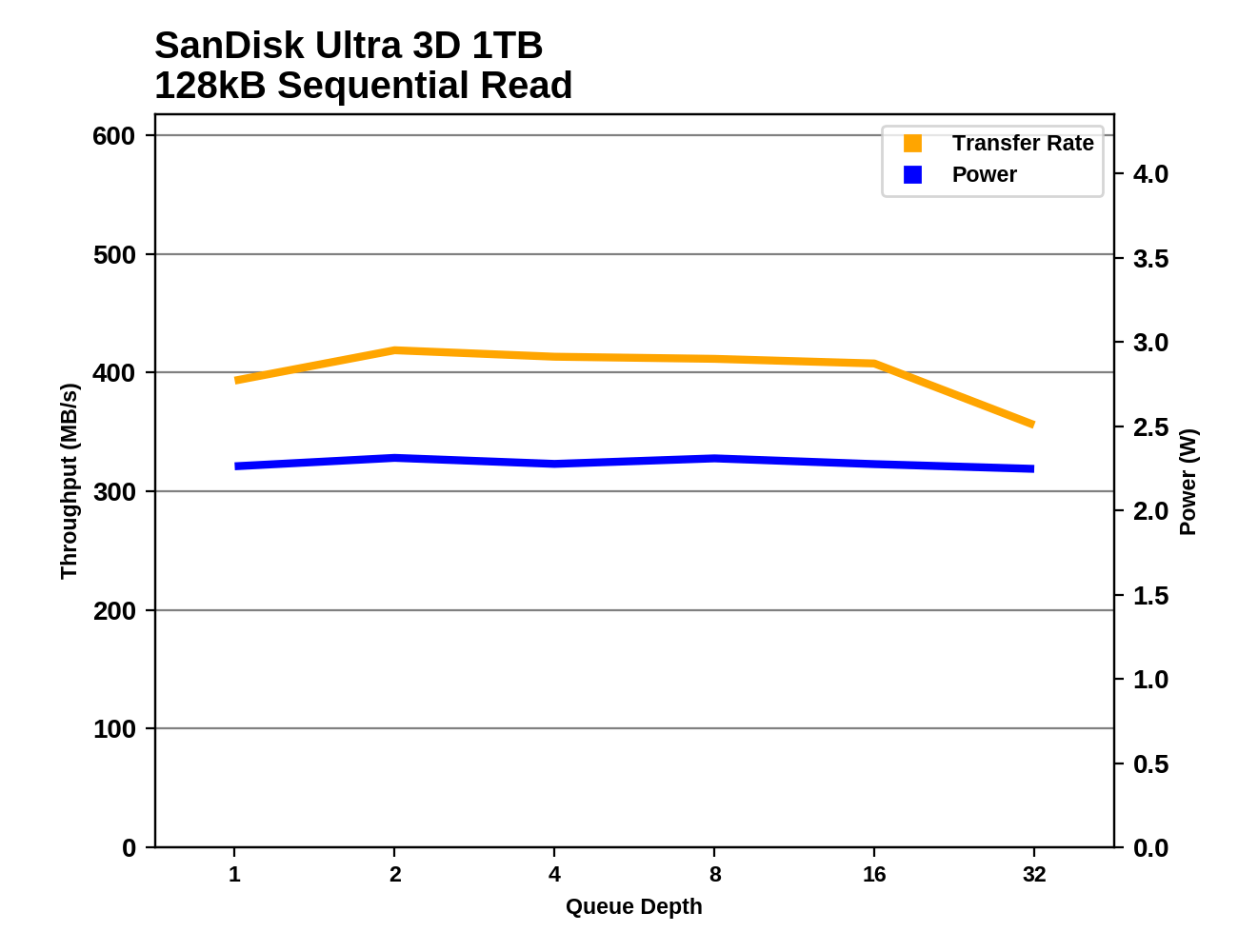One Design, Two Products: The SanDisk Ultra 3D (1TB) and WD Blue 3D (1TB) SSD Reviews, with BiCS 3D NAND
by Billy Tallis on September 14, 2017 9:00 AM ESTSequential Read Performance
Our first test of sequential read performance uses short bursts of 128MB, issued as 128kB operations with no queuing. The test averages performance across eight bursts for a total of 1GB of data transferred from a drive containing 16GB of data. Between each burst the drive is given enough idle time to keep the overall duty cycle at 20%.

Orange is for the new drives, Blue is for the previous generation models
The burst sequential read speeds of almost all of these SATA drives are essentially equivalent; the slightly lower scores from the new WD and SanDisk drives are not a meaningful drop from the previous generation.
Our test of sustained sequential reads uses queue depths from 1 to 32, with the performance and power scores computed as the average of QD1, QD2 and QD4. Each queue depth is tested for up to one minute or 32GB transferred, from a drive containing 64GB of data.

On the longer test of sequential reads, the WD Blue 3D NAND and SanDisk Ultra 3D end up in the second tier of SSDs, tied with the Intel 545s and Toshiba's MLC-based OCZ VX500, but Samsung's 850 PRO and 850 EVO still have a substantial performance advantage.

The power efficiency of the WD Blue 3D NAND and SanDisk Ultra 3D is excellent, trailing behind only the MLC-based OCZ VX500 that also uses a reduced amount of external DRAM. The previous generation of SanDisk and WD drives had the same power efficiency as Samsung's 850 PRO and EVO, which was good by last year's standards.
 |
|||||||||
From QD1 to QD2, the WD Blue 3D NAND and SanDisk Ultra 3D see a slight improvement in sequential read performance and don't benefit any further from higher queue depths. The Samsung 850 PRO and 850 EVO both show a much larger jump in performance from QD1 to QD2, leading to a higher steady-state sequential read speed. The OCZ VX500 can actually match the Samsung drives at high queue depths, but it doesn't saturate until QD4.
Sequential Write Performance
Our test of sequential write burst performance is structured identically to the sequential read burst performance test save for the direction of the data transfer. Each burst writes 128MB as 128kB operations issued at QD1, for a total of 1GB of data written to a drive containing 16GB of data.

As with sequential reads, the burst sequential write speed of the new WD and SanDisk drives is slightly reduced from the preceding generation, but the performance isn't low enough to make the new drives stand out from the crowd.
Our test of sustained sequential writes is structured identically to our sustained sequential read test, save for the direction of the data transfers. Queue depths range from 1 to 32 and each queue depth is tested for up to one minute or 32GB, followed by up to one minute of idle time for the drive to cool off and perform garbage collection. The test is confined to a 64GB span of the drive.

The performance of the WD Blue 3D NAND and SanDisk Ultra 3D on the longer sequential write test is much improved from the previous generation of drives, but still rather slow compared to the competition.

With a substantial performance boost, the power efficiency of the latest WD/SanDisk SSDs is now about average, and is competitive with Samsung's drives but far lower than what the Crucial MX300 or OCZ VX500 offer.
 |
|||||||||
The mediocre sustained sequential write performance of the new WD/SanDisk 3D NAND SSDs is due to a combination of relatively low performance once the drive has reached its full performance, and a slow ramp up that is still not quite at full speed by QD4. Most drives are operating at or very near their full performance at QD2.










52 Comments
View All Comments
Georgeepo - Thursday, September 10, 2020 - link
https://clck.ru/QB2NWРаньше пользователи CryptoTab PRO могли торопить майнинг лишь около помощи функции Cloud.Boost. Мы решили начинать дальше и предоставить вам доступ к новейшей опции Super.Boost, для вы зарабатывали больше — и быстрее! Оцените преимущества сверхскоростного майнинга с расширением Super.Boost, доступным в PRO-версии Android приложения.
Используйте зараз скольконибудь ускорений Super.Boost и увеличьте общую быстрота майнинга на всех ваших устройствах с включеннойй функцией Cloud.Boost. https://clck.ru/QB2NY
Например, скорость вашего устройства — 100H/s, с Cloud.Boost X10 скорость составит уже 1000H/s. А с двумя дополнительными ускорениями Super.Boost +80% и +60% суммарная быстрота майнинга довольно равна 2400H/s (1000H/s + 1000H/s*0,8 + 1000H/s*0.6 = 1000 + 800 + 600).
Скачай CryptoTab PRO и открой ради себя сверхбыстрый майнинг! https://clck.ru/QB2Bo
Устанавливая PRO-версию Android-приложения кроме опции Super.Boost, вы также получите расширенный коллекция функций:
Cloud Help — часто ускоренный майнинг
Функция SDP: сервер-зависимый майнинг не тратит заряд батареи
Резвый доступ к кабинету чтобы хранения и вывода криптовалюты
Неограниченное мера подключённых удалённых устройств
Обновление баланса раз в 10 минут
Неограниченный заключение средств от 0.00001 BTC
Отдельные профили для разных пользователей
Защищенный профиль ради публичного Wi-Fi
Приоритетная техническая помощь
Адаптивная новостная лента
Никакой надоедливой рекламы
Специальные промо-материалы и распродажи
Майнинг на мобильных устройствах паки никогда не был таким быстрым! Скачай Android-приложение, включи Cloud.Boost и открой для себя суперскоростной майнинг с функцией Super.Boost.
Перейти по ссылке: https://clck.ru/QAzhJ
@Crypto_Good